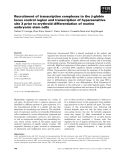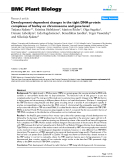
Chromosomal changes
-
The development of fruits without fertilization is known as parthenocarpy. Parthenocarpy improves the fruit quality, processing attributes, production and productivity of vegetable crops like tomato, cucumber, watermelon etc. Absence of seeds can enhances the shelf life of the fruits, allowing a better conservation, fruit set in adverse climatic conditions, early and offseason production of vegetable crops. Therefore, it is important to ensure yield stability regardless of environmental conditions.
 20p
20p  gaocaolon5
gaocaolon5
 14-06-2020
14-06-2020
 20
20
 3
3
 Download
Download
-
Eukaryotic chromosomal DNA is densely packaged in the nucleus and organized into discrete domains of active and inactive chromatin. Gene loci that are activated during the process of cell differentiation undergo changes that result in modifications of specific histone tail residues and in loosening of chromatin structure. Theb-globin genes are expressed exclusively in eryth-roid cells.
 10p
10p  dell39
dell39
 27-03-2013
27-03-2013
 53
53
 6
6
 Download
Download
-
Tuyển tập báo cáo các nghiên cứu khoa học quốc tế ngành y học dành cho các bạn tham khảo đề tài: Development-dependent changes in the tight DNA-protein complexes of barley on chromosome and gene level
 16p
16p  panasonic06
panasonic06
 25-12-2011
25-12-2011
 50
50
 3
3
 Download
Download
CHỦ ĐỀ BẠN MUỐN TÌM
















